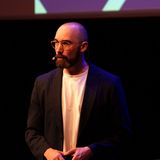Design is everywhere, and everything is designed. Thus, the job title of ‘designer’ encompasses hundreds of industries, job titles, and career paths. What is design and what does it comprehend? In what way does design influence our daily life? How do we design and what skills are needed? And what does it take to be the actual person doing the design?




Rudy van Belkom (Rotterdam) is a researcher, innovator, speaker, and author in the field of Technology & Democracy. He is also the founder of Design for Transition, a Futures Research & Design Agency. According to Rudi, everything around us was once designed and can therefore be redesigned! Society is constantly changing. So why are our social structures and systems not adapted to this? For example, the current Dutch electoral system has been unchanged since 1918. Based on his social involvement, he started an exploration of a new political electoral system – and designed an alternative modular voting system. The New Vote (in Dutch: Het Nieuwe Kiezen) was nominated for The Index Project’s Community Award.
As a creative thinker and a purpose-driven architect, business developer and marketer, Nyasha Harper-Michon (Amsterdam) strives to lead by example, empower and incite others to act for a resilient, sustainable and circular future. Nyasha sees herself as an Archtivist – a term she introduced in her MArch thesis at Academie voor Bouwkunst, and which is used for architecture and design professionals driving economic, environmental, and social reform to foster positive changes in society. Challenging the status quo and the question ‘why’ play a central role in her thought process. Having an open-minded and empathetic outlook are essential skills for designers and an essential source of inspiration that continues to enhance creativity. For Nyasha, it has inspired her to work hard to contribute to fostering diversity and inclusion within the architecture and design field.
Academic (educator), annotator, researcher, and technologist Nishant Shah (Arnhem) conducts work on the cutting edge of technology, identity, and social and political movements. He is the Director of Research and Outreach and Professor of Aesthetics and Cultures of Technology at the ArtEZ University of the Arts, where he is responsible for building a research corpus that looks at the role that art and design education and practice can play towards building resilient futures, equitable societies, and critical diversity. Nishant is also connected as a Faculty Associate to the Berkman Klein Center for Internet & Society at Harvard University, where he examines the current conditions of technology, culture, fakeness, and art. His book Really Fake, will be available in March 2021. According to Nishant, design thinking begins with asking the right question. What would those questions be?

Melis Senova (Melbourne) is a pioneer in human-centered design and founder of global strategic design consultancy Huddle. Her vast business experience, underpinned by a Ph.D. in Human Factors (human-centered design), sees her focused on reshaping the super systems of the future. This reshaping is essential to ensure we address the complex challenges facing humanity and the planet. Melis believes we can change our realities by changing our minds. Melis is the author of This Human, in which she gives a new perspective on design thinking. There are many great books about the design process, tools, and methods. One missing aspect, almost in an ironic twist, is what it takes to be the person who is actually doing the designing. This Human is about that person – you.

With code DCFA2122 you get a 10% discount on This Human at Athenaeum Bookstore. Use this link to be referred to the shop.

Issuu - In 2021, Pakhuis de Zwijger's extensive activity programme will commence with the support of the Creative Industries Fund NL. In the context of the super-diverse city, how can designers contribute to the creation of inclusive cities for, and by everyone? ‘Cities of Belonging’, as we would call them, cities in which everyone feels and is allowed to feel at home. Not only in a spatial sense but also with regard to the digital domain and relating to the design of our public systems, services, and products. >>

Youtube - Online lecture and workshop by Nishant Shah: The quantified future was always scarce: Constant catastrophization & computational counting. >>
Dezeen - Dutch designer Rudy van Belkom has envisioned a radical new electoral system that would allow voters to pick and choose policies from different political parties. How can designers offer solutions to the world's biggest problems? >>

SXSW - As designers, our intentions are typically good: we seek positive outcomes of our work, but sometimes even the most well-intentioned strategies darken. Dr Melis Senova invites the audience to explore aspects of the practice often not discussed. >>

BNA - Nyasha Harper-Michon noemt zichzelf een ‘Archtivist’. Haar ideaal is dat architectuur een positieve impact heeft op het welzijn en de gezondheid van mensen, groepen en uiteindelijk de gehele planeet. Momenteel verdiept ze zich daarom in de klimaatcrisis en duurzaamheid. Daarnaast gaat de inclusiviteit binnen de architectenbranche – of beter gezegd, het gebrek daaraan – haar aan het hart. >>





